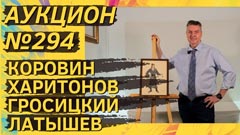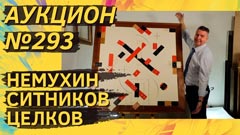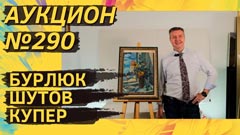
1960s UNOFFICIAL ART
KUPER Yuri Leonidovich (1940) Tulip. 2009. Canvas, oil, author's technique. 100 × 100
The stunningly beautiful meter oil by the main master of sfumato in post-war unofficial Russian art. Kuper came to sfumato, a painterly technique of depicting air invented by Leonardo, while in exile, where he left in 1972. In the Soviet Union, he was more of a follower of surrealism. But one day his photographer friend John Stuart told him, “Look, you're a fine artist, but you're doing some nonsense. Why don't you just paint reality? Those objects around you”. And from about this point we can count the era of the new Kuper. The artist changed: he began to paint his instruments, brushes, interior objects. And it turned out that you can enter the history of art, not only through conceptual moves, and quite within the framework of the classical school.
BELENOK Petr Ivanovich (1938–1991) Revelation of a loner. 1979. Hardboard, author's technique. 142 × 122
The peculiarity of this work is not only a meter and a half museum size. And not only in impeccable provenance (on the back mounted momentary photo with the artist's widow on the background of this painting). The fact is that this is a rare example of a positive picture of Belenok. There is no depression and panic. Even on the contrary. There is carnival, sensuality and even erotic overtones. We rarely see Belenok like this. Such a picture will always delight the eye. In this case, its decorativeness exactly has not gone to the detriment of the philosophical component. This means that the work does not get bored — the viewer will always discover something new in it.
VECHTOMOV Nikolay Evgenievich (1923–2007) Mergers. 1988. Oil on canvas. 60 × 80
Rare blue Vechtomov. According to our observations, there is only one blue work of the artist for every ten works of red color appearing on the auction market. It is in the blue works of the artist that the luminous effect is especially pronounced, as in Kuindzhi's “Night over the Dnieper”. In addition, this gamut visually leads away from the original nature of Vechtomov's biomorphic artifacts. The artist himself said that these are impressions from the flashes of explosions he saw in the war. But there are absolutely no such associations in the blue scale. All that remains is the pure surreal beauty of the unearthly landscape.
ZVEREV Anatoly Timofeevich (1931–1986) Merry Mom. 1956. Oil on paper. 41 × 58
“Merry Mom” is a very personal sketch by Zverev. It is somewhat intimate. The oil, which depicts an old woman with a bottle, comes from the collection of George Costakis. Zverev was a favorite of the collector who discovered the first Russian avant-garde. Costakis called the artist “Tolichka” and was not just a mentor, but the creator of the artist's legend in the 1950s.
Today, Zverev's works from the Costakis collection are rare by definition. There used to be a lot of them, but then fate scattered them all over the world. In the USSR there are almost none of them left. So for collectors, the appearance of “Merry Mom” at the auction in Russia is an unconditional luck.
MIKHNOV-VOITENKO Evgeny Grigorievich (1932–1988) Abstract composition. Spring. 1958. Oil on canvas. 68 × 40
Mikhnov-Voytenko was a St. Petersburg avant-garde artist, one of the main innovators of abstract art in the postwar period. The “Iron Curtain” prevented the artist from making his voice heard at the world level. Although researchers note that in a number of artistic techniques he was definitely ahead of European and American artists. The abstract composition of 1958 is painting on canvas. Even this is already a rarity, since most of Mikhnov-Voitenko's works on the market are gouache, graphics. One of Mikhnov's innovations is still called “tubes”. It is a technique where he formed abstract structures by squeezing paint from tubes directly onto the canvas, without a palette and without using a brush. It is a kind of graffiti on canvas, only not from a spray can, but from tubes. The same technique is also partly used in our work. Even though there is no ascetic “tubes” in their pure form, their role in the overall composition is decisive.
Mikhnov-Voytenko is a Leningrad Sixties artist. So non-public that he did not even participate in the resonant St. Petersburg exhibitions at the Nevsky and Gaza Culture Houses. Mikhnov-Voitenko worked as a turner, studied at the Pedagogical Institute of Foreign Languages, then at the Theater Institute at the staging department. Worked at the art factory, made custom decorative panels and signs. He died early, at the age of 56. In fact, he entered the history of art with works made on the table.
BORUCH (Steinberg Boris Arkadievich, 1938–2003) Composition. 1970. Wood, metal, mixed media. 80 × 50 × 4
Boruch of 1970. Inscribed, geometric-abstract, with signature object multi-facetedness. Boruch is the pseudonym of Boris Steinberg, son of Arkady Steinberg and brother of Eduard Steinberg. Boruch became one of the most uncompromising figures of unofficial art. He befriended foreigners, went to embassies, spent money defiantly, threw parties on motor ships, etc. And at the same time the authorities could not find a way to stop him. After all, the artist did not go to the service, did not work in publishing houses and art plants. He bowed before the majors and did not respond to their “urgent requests”. And it turns out that it was possible. Difficult, but possible. The 1970 composition is an exemplary work by Boruch, an unquestionable museum level.
NEMUKHIN Vladimir Nikolaevich (1925–2016) Tea pair with a geometric composition
The tea pair, contrary to its name, includes three items: a cup, a saucer, and a dessert plate. The supremacist set of a sweet tooth. Before us is another dialogue between Nemukhin and the artists of the first Russian avant-garde, which he first heard about from his teacher Sokolov, and later saw live at Costakis. There is an interesting story associated with this porcelain. It was made by the firm Bestform, and it was this cooperation that became fatal in Nemukhin's porcelain history. Earlier, the artist had signed a contract with the influential Villeroy & Boch. Business was going well. But under the contract, Nemukhin could not choose the form — only painted that “linen”, which he was given. This weighed on the artist. And then Bestform came along, promising him freedom of choice — he could order the porcelain moulds himself. And the artist agreed. But the price turned out to be high. “Villeroy” learned about this, terminated the contract and gave Nemukhin a “wolf ticket”. After this, the artist could not work with the major porcelain factories. So, at least, so says the legend.
The pair is published in the catalogue “Porcelain of the Sixties. Collection of Irina and Victor Minchin” on page 36.
1970s UNOFFICIAL ART
NAZARENKO Tatyana Grigorievna (1944) Masks. 2020. Oil on canvas. 75 × 100
Tatyana Nazarenko is the Seventies artist, an “Amazon of the leftist MOSKh (Moscow branch of the Union of Artists)”. Like Natalia Nesterova, she was not in the political, but in the aesthetic opposition. Nazarenko was not a member of the nonconformist camp, but was close to unofficial art. She was not forbidden to exhibit, her works quickly found their way into the halls of the Tretyakov Gallery. But the aesthetics of her paintings dramatically contrasted with the timeserving socialist realism. “Masks” is a carnivalesque, melancholic work. New Year's Eve in spirit and very moody. An excellent choice for a collection.
- Log in to post comments










